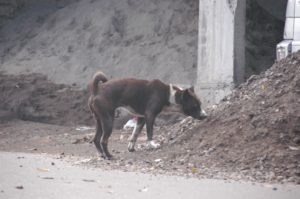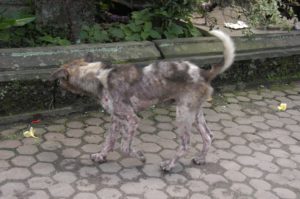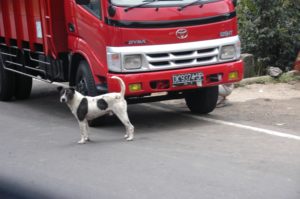Sophia’s Indonesia Trip — Day 3 (Sept 2009)
Today we’ve arrived on Bali, an island described as Paradise and one also known for having many stray dogs. Virtually all developing countries have many stray dogs and the dog population is a good reminder of how dogs co-evolved alongside man. That is, while a common idea is that humans purposefully domesticated dogs by stealing wolf pups from dens and then selectively breeding the ones they liked, this process would be labor intensive, especially considering the fact that, even now, to get a tame wolf you must hand rear them starting before 14 days of age.
An alternate hypothesis to the labor intensive and potentially hazardous method of plucking wolf pups from the den and then hand-raising them is the model of self-domestication supported by Darcy Morey, as well as Ray and Lorna Coppinger. This hypothesis says that as humans moved into permanent settlements, they also developed trash sites that some wolves were able to exploit for food. Those that were the tamest or least fearful and best able to scavenge in this environment survived and reproduced better. Their pups inherited this degree of tameness and, in turn, survived better than their peers.
In time, populations of “village wolves” arose in many different settlements around the world. Due to the decreased fear in these village wolves, humans were able to interact with them easily. At first, they started playing favorites by tossing food to those individuals they liked best, with no specific goals for long-term artificial breeding programs. Then, at a more recent point in time, humans started to systematically select dogs for specific traits, which led to the development of many different dog breeds.
This method of self-domestication is supported by findings in other animals, as well as in the current state of the world’s dogs. Three quarters of the world’s dog populations live in developing nations as village dogs. Like the model of the village wolf, they scavenge from human discards and are considered pests rather than pets. Bali is a good glimpse into how this system works.
Bali is Overrun with Dogs
Janice Ghirardi from Bawabali.com estimates about 1 dog to every 5 people here. Based on our morning drive from the airport all the way to the other side of the island, these numbers are likely to be true. On our drive we see about one dog every minute. Most that I see have clear signs of mange, a skin problem caused by either demodectic or sarcoptic mites. The primary sign is intense itchiness and hair loss due to scratching. The skin is red from inflammation and scratching and over time can become thickened and black. One of the most common postures I see as we drive by dogs is the sitting-itching posture.
Most of the dogs have a tired look on their face because the skin condition has caused their ears to tilt forward. I can’t yet tell whether the dogs are happy or just getting by since I only see them while we drive by. But I hope to interact with dogs later on in our trip. I’ll also get a better idea later on whether most dogs look as bad as the ones I see on my first day in Bali.
Dogs and Cars
With dogs so close to the road, you might think that these dogs have an innate ability to avoid cars. But as we’re driving on the main 2-lane road, I do see dogs walking right into the street. Due to the crazy driving style here-where you learn that actually 3, not 2, cars can fit in a 2-lane road drivers here are more alert and ready to avoid dogs as well as other cars, people and motorcycles. In spite of this, many dogs are still hit by cars. According to Janice Ghirardi, Bawabali easily gets 5 calls a day from people who’ve reported dogs hit by cars. A majority of people on the island wouldn’t know who to call, however, so there are many more killed that they never hear about.







